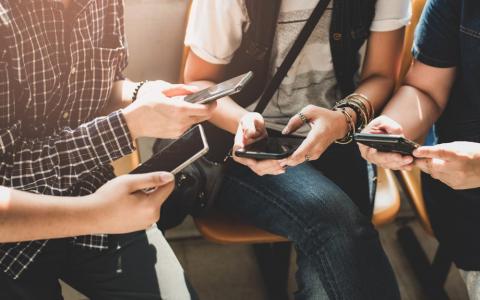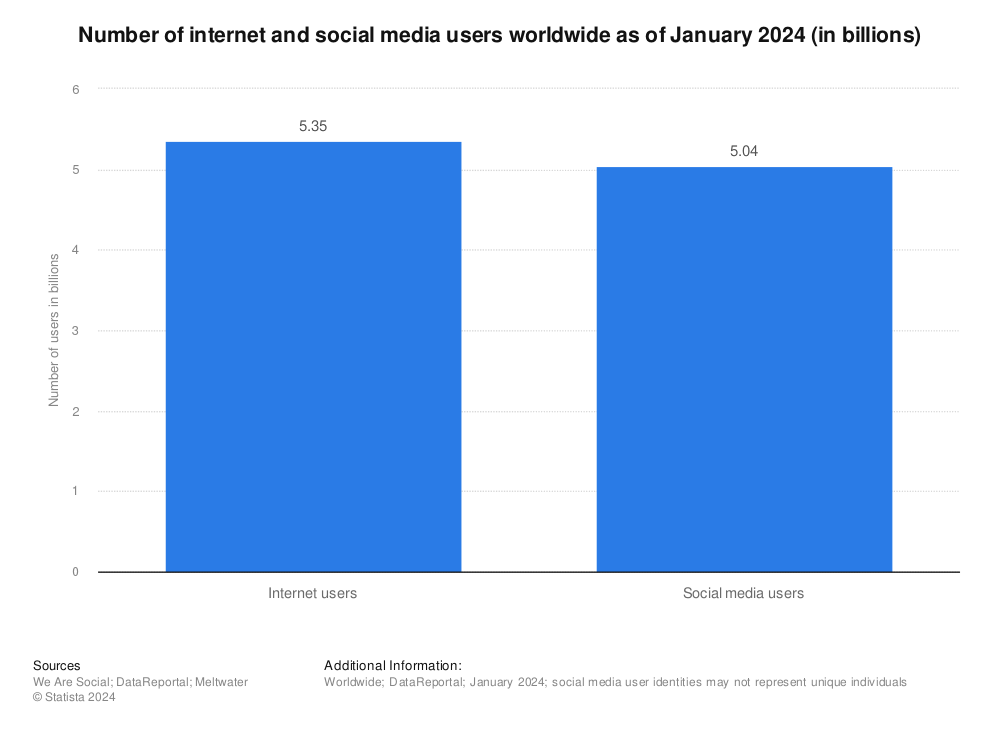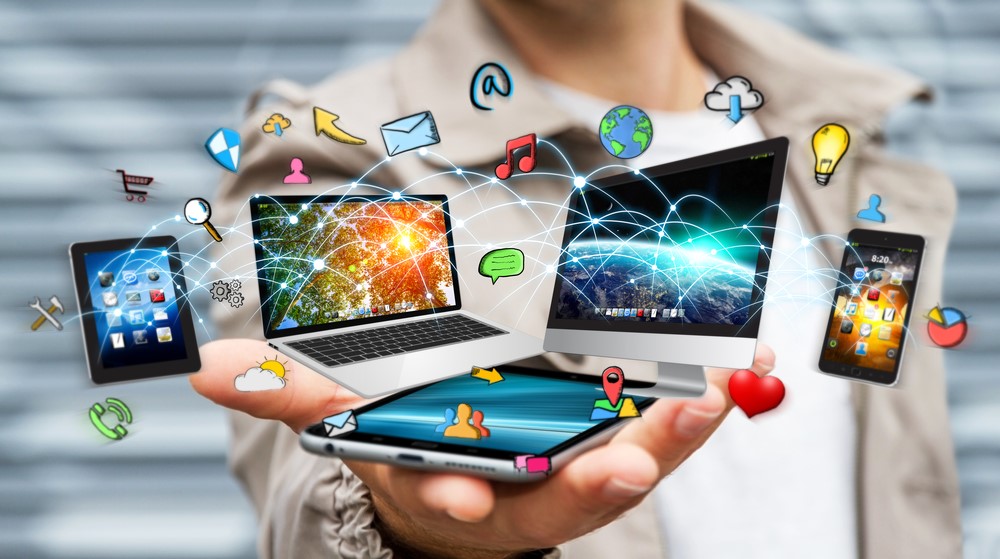Mental Health and Wellbeing Risks from Rising Digital and Social Media Usage

Patricio V Marquez
March 12, 2024
Technological innovation is fueling momentous change in our daily lives. Indeed, as Professor Klaus Schwab, Chairman of the World Economic Forum (WEF), has observed, the physical, digital and biological trends underpinning what he calls 'the fourth industrial revolution' are unleashing changes “unlike anything humankind has experienced before”. At the center of it all is the Internet, anchoring digital media.
While these changes are positive, they also pose some risks that merit attention. In this blog, I will discuss mental health and wellbeing-related risks and ways to mitigate them.
Digital Media and Its Usage
Digital media refers to content that is created, stored, and shared using digital technology that come from the media, entertainment, and the information industry. This includes text, audio, video, and graphics, encompassing a wide range of formats like digital newspapers, e-books, podcasts, digital video, online courses, and websites. Its purpose varies widely, from entertainment to education, and it is not necessarily interactive or social in nature. The most popular devices for accessing digital media remain laptops and desktops, but mobile devices, such as smartphones, are fast catching up in popularity and use worldwide.
Indeed, the easy-to-carry and handle, multi-functional smartphone, is nowadays a common, and may I say, dominant feature of modern life that has revolutionized access to information and connectivity. Globally, 73 percent of the population aged 10 and over owned a mobile phone in 2022. In low- and middle-income countries, this technology is leapfrogging traditional digital adoption, moving consumers directly from no digital use to mobile use (in most of these countries, mobile broadband (3G or above) is the main way — and often the only way — to connect to the Internet).
According to data from different countries worldwide, the average person spends 3 hours and 15 minutes on their smartphone phone every day; people check their phones 58 times per day; and almost 52 percent of phone checks (30 per day) occur during work hours. Picking the phone up can become a habit as data shows that half of all screen time sessions begin within 3 minutes of the last.
Expanding Reach of the Internet and Social Media
As shown in Figure 1, Internet and social media reach is vast. As of January 2024, there were 5.35 billion internet users worldwide, which amounted to 66.2 percent of the global population. Of this total, 5.04 billion, or 62.3 percent of the world's population, were social media users.
As of 2022, global Internet usage was higher among young people aged 15 to 24 years across all regions, with a worldwide average for this age group of 75 percent, 10 percentage points more than among the rest of the population. About 92 percent of the population of high-income countries reportedly used the Internet, as opposed to only 26 percent in low-income countries. In Africa, international bandwidth usage shows the fastest growth (37 percent), while the fastest growing region in terms of bandwidth usage per Internet user is the Americas (26 percent).
Figure 1

Social media, an integral part of digital media, comprises websites and applications designed for rapid, efficient, and real-time sharing of content. These platforms enable users to create profiles, connect, share information, ideas, and interests, and engage in social networking. Most platforms offer web-based interfaces and mobile applications for accessibility.
A notable aspect of social media usage is its diversity; the average user maintains a presence on six to seven different platforms monthly. As of 2024, Facebook leads as the world's most popular social media platform, with a monthly user base exceeding 3 billion, representing about 37 percent of the global population. WhatsApp, a widely used messaging app, ranks second with a presence in over 180 countries and 2.78 billion active users monthly. YouTube holds the third spot as the world's preeminent video-sharing platform, attracting an average of 2.49 billion monthly visitors. Instagram, with 2.04 billion monthly active users; WeChat, with approximately 1.32 billion users per month; and TikTok, a rapidly growing platform, with about 1.22 billion monthly active users, follow.
As of 2022, the average daily social media usage of Internet users worldwide amounted to 151 minutes per day, up from 147 minutes in the previous year. In many countries, social media use has become a common part of many teens’ daily routine. For example, data from a survey on social media and tech use among teenagers in the United States show that in 2023 up to 95 percent of youth ages 13–17 report using a social media platform, with more than a third saying they use social media “almost constantly.”
Social Media Impact
Social media has a wide-reaching and significant impact on not only online activities but also offline behavior and life in general. Data from a global online user survey conducted in February 2019 indicated that a significant share of respondents felt that social media had increased their access to information, ease of communication, and freedom of expression. The respondents also felt that social media had worsened their personal privacy, increased a polarization in politics, and heightened everyday distractions.
Recent literature elaborates on the likely pathways between excessive social media use and psychological effects in young people, including:
- Cognitive and Behavioral Skill Impairment: Excessive social media use can adversely affect the development of cognitive skills such as thinking, imagination, reasoning, and memory, as well as behavioral skills, which include reactions to environmental stimuli.
- Altered Social Interaction Patterns: Overreliance on social media can lead to a shift in social interaction patterns. The face-to-face communication vital to families, communities, and workplaces risks being replaced by online interactions.
- Decline in Empathy: The reduction in face-to-face communication could be contributing to a decline in empathy, defined as understanding and sharing the feelings of others.
- Facilitation of Negative Behaviors: Social media can enable bullying, harassment, social defamation, and hate speech by lowering the perceived risks of such behaviors and making it easier to engage in harmful activities. For instance, a global survey by Vodafone showed that out of over 4,700 surveyed teenagers, half perceived cyberbullying as more harmful than face-to-face bullying, with significant percentages reporting feelings of depression and suicidal thoughts. The tragic suicides of K-pop stars Koo and Sulli, victims of cyberbullying, underscore this issue's severity.
The social distancing measures, lockdowns, and school closures adopted in many countries during the COVID-19 pandemic to prevent and control the spread of the virus led to increased social isolation and a dramatic rise in social media use among children and adolescents. This surge has been linked to a rise in cyberbullying, depression, self-harm, sexting, hate speech, human trafficking, and addiction to social media.
Overall, these trends point to a pressing need for greater awareness and strategies to mitigate the negative impacts of excessive social media use on individuals and society, particularly on children and adolescents. In some countries, such as the United States, social media companies are now facing mounting legal risks from claims that they use algorithms to get teenagers and adolescents addicted to their platforms akin to the tactics of used by the tobacco companies, as well as calls for strict regulatory measures to protect children from being harmed online.
Mental Health Risks
The excessive use of social media and the way it is used present numerous risks to users, particularly by increasing susceptibility to addiction and negatively impacting mental health and wellbeing. A comprehensive assessment done for the World Economic Forum highlights mental health risks associated with constant social media usage:
- Overload: The stress resulting from the extensive volume and diversity of social media interactions.
- Invasion: The encroachment of media connections into personal life.
- Uncertainty: The constant and unpredictable changes in social media applications and their requirements.
Additional risk identified included:
- "Envy-related stress": Arising from continuous exposure to updates about others' achievements and lifestyles, which may trigger feelings of inadequacy.
- Decline in civility: The anonymity of electronic interactions often leads to blunter and more negative exchanges compared to face-to-face encounters.
- Addictive behavior: Similar to substance abuse or gambling addiction, excessive video gaming can trigger changes in brain chemistry, particularly concerning dopamine, a neurotransmitter associated with reward and pleasure. This can lead to the repetitive pursuit of these 'highs'.
- Association with anxiety and depression: Distinct patterns of social media use have been linked with symptoms of depression and anxiety, and other disorders. For example, a study showed that many teenagers who suffered negative emotional states, especially anxiety and depression, during the COVID-19 outbreak, chose Internet games to cope with negative emotions. Under the mediation of fear of missing out, teenagers with anxiety were more likely to develop Internet gaming disorder, while teenagers with depression or stress were prone to other types of Internet use disorders. Another study found a stronger association between social media use and depressive symptoms in girls, with poor sleep, online harassment, body image issues, and low self-esteem as contributing factors.
- Impact on cognition: Extensive social media use can diminish attention spans and reduce recall rates for information that is readily available online.
- Reduced downtime: The increased use of social media can decrease periods of inactivity, which are vital for the brain to process information, forge idea connections, and develop self-awareness.
The above findings were further corroborated by those in a Wall Street Journal exposé that reported that own research conducted by Facebook showed that Instagram harms the mental well-being of its teen users. But, instead of publicizing the findings and moving to protect children from harm, Facebook did not make the research public.
Physical Health Risks
The detrimental impact of excessive digital and social media use on physical health can be underscored by two significant risks:
- Increased sedentary lifestyle: World Health Organization data suggests that time spent on digital and social media displaces time that could be spent on physical activity. Lack of physical activity has been identified as the fourth leading risk factor for global mortality (6 percent of deaths globally). Physical inactivity is estimated to be the main cause for approximately 21–25 percent of breast and colon cancers, 27 percent of diabetes cases, approximately 30 percent of the ischemic heart disease burden, and of childhood obesity, which is one of the most serious public health challenges of the 21st Century affecting countries across the income spectrum, particularly in urban areas (in 2022, obesity in school-aged children and adolescents was more prevalent than thinness with a probability of at least 0·80 among girls in 133 countries (67 percent) and boys in 125 countries (63 percent). Overweight and obese children are likely to stay obese into adulthood and more likely to develop chronic diseases like diabetes and cardiovascular diseases at a younger age.
- Increased risk of traffic injuries: The use of smartphones, particularly while driving, is a significant contributor to traffic injuries and fatalities, especially involving young drivers. For example, research results from the United States indicates that using a phone while driving drastically increases the likelihood of crashes or near-miss crashes. For example, while driving light vehicles and cars, the risk of a crash or near-miss crashes is elevated as follows:
- Dialing a cell phone increases the risk by 2.8 times compared to non-distracted driving.
- Talking or listening on a cell phone increases the risk by 1.3 times.
- Reaching for an electronic device, such as a cell phone, increases the risk by 1.4 times.
In the context of heavy vehicles and trucks:
- Dialing a cell phone increases the risk by 5.9 times.
- Surprisingly, talking or listening on a cell phone does not significantly alter the risk compared to non-distracted driving.
- Using or reaching for an electronic device amplifies the risk by 6.7 times.
- Text messaging elevates the risk to a staggering 23.2 times. Notably, large trucks comprise nearly 10 percent of all vehicles involved in fatal crashes in the United States.
These findings highlight the critical need for awareness and preventive measures to mitigate the health risks associated with high digital and social media use.
Impact on Children’s Wellbeing
The World Economic Forum assessment cited above highlight several potential adverse effects of social media use on children, emphasizing the need for balanced and controlled digital media interaction. These include:
- Neurological and developmental issues: Excessive use of new media can contribute to attention problems, school difficulties, and sleep disorders, particularly in children aged 3-5 exposed to violent content. This exposure also raises the risk of eating disorders and obesity.
- Impaired social and cognitive development: Substituting parent-child and peer interaction with digital media interaction can negatively impact brain development, social skills, and cognitive abilities. Social interactions are crucial during early life, and a lack of these can cause irreversible social and cognitive impairments.
- Sensory system imbalance: Heavy reliance on digital media often overstimulates the visual and auditory systems while under-engaging other sensory systems such as vestibular (balance), proprioceptive (body movement and position), and tactile (touch). This imbalance can potentially lead to long-term developmental issues.
- Language development delays: Very young children (9-18 months) do not effectively learn language from educational videos without active interaction with others, suggesting a limitation of digital media in language acquisition.
- Poor academic performance: Uncontrolled time spent on digital media often displaces time spent on academics, lowering academic achievement.
- Exposure to harmful content: Digital media make it easier to disseminate inaccurate as well as accurate information, and much that is online is potentially harmful to younger audiences. For example, a New York Times article documents how through video games and online chats, sexual predators are making virtual connections with children. The criminals strike up a conversation and gradually build trust, often posing as children, confiding in their victims with false stories of hardship or self-loathing with the goal of duping children into sharing sexually explicit photos and videos of themselves — which they then use as blackmail for more imagery, much of which is increasingly graphic and violent.
As Marc Berkman, CEO of the Organization for Social Media Safety has observed, educating and raising awareness among children and parents alike about of growing social media-related dangers like cyberbullying, human trafficking, and fraud, is needed to protect children by helping them understand how to avoid or safely react and deal with these threats.
Impact on Adolescents’ Wellbeing
Adolescents often view social media as detrimental to their mental well-being, associating it with mood and anxiety disorders, a platform for cyberbullying, and addictive behaviors. Research, such as that by Twenge et al. (2019), indicates a correlation between the increase in psychological distress, depression, suicidal thoughts, and actual suicides among adolescents and young adults with the rise of social media use and lack of sleep. Conversely, studies like that by Tandon et al. (2021) suggest that reduced screen time and increased physical activity are linked to better mental health.
As shown by the results of a systematic review, a positive relationship was found between excessive digital technology usage and negative psychological and emotional outcomes in users aged 14–18, and a statistically significant difference was found between girls and boys, with girls experiencing more negative outcomes than boys. A study published in The Lancet focusing on social media use and adolescent mental health corroborated these results, documenting that the magnitude of association between social media use and depressive symptoms was larger for girls than for boys via multiple potential intervening pathways---greater hours social media use related to body weight dissatisfaction, which in turn linked to depressive symptom scores directly and indirectly via self-esteem. More disturbingly, as highlighted in a recent New York Times article, health and technology experts cautioned that social media presents a “profound risk of harm” for girls, as constant comparisons to their peers and face-altering filters are driving negative feelings of self-worth and promoting objectification of their bodies.
These findings underscore the importance of monitoring and regulating social media use among adolescents to mitigate its potential negative impacts on their mental and developmental health, particularly considering the reported rising trend in mental health issues among adolescents worldwide post COVID-19 pandemic.
More specifically, a report by the United States Surgeon General, offers practical recommendations to help families guide children’s social media use, including keeping mealtimes and in-person gatherings free of devices to help build social bonds and promote conversation, as well as creating a “family media plan” to set expectations for social media use, including boundaries around content and keeping personal information private.
Takeaways
Amid rapid technological change, and growing access to digital and media technologies, it is crucial to strike a balance between the benefits offered by having expanded access to these technologies, and the potential risks of excessive connectivity and usage. Specifically, it is important to confront the mental health and wellbeing risks associated with excessive digital and social media use, particularly among children and adolescents, to ensure that the digital revolution positively impacts individuals and society, while addressing and mitigating social harms, such as those that may hamper the development of human capital in a society.
Source of Image 1: Stock Photo ID: 1280794843
Source of Image 2: Stock Photo ID: 520492693

